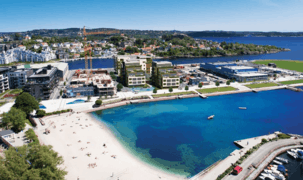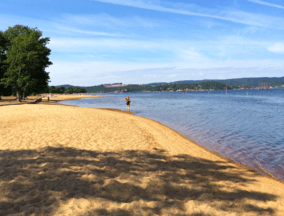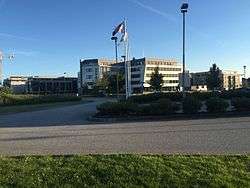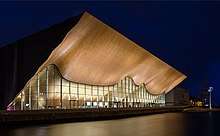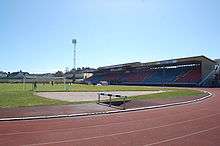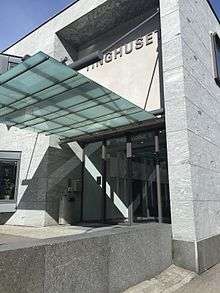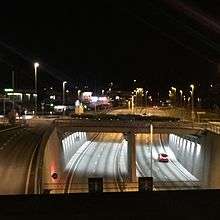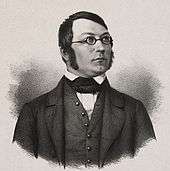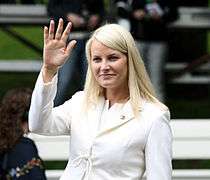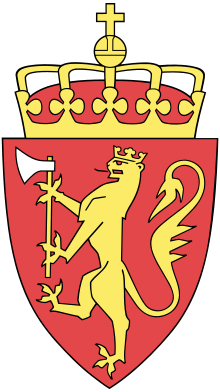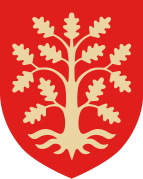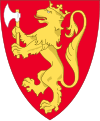Kristiansand
Kristiansand[lower-alpha 1] (/ˈkrɪstʃənsænd/,[2][3] also US: /ˈkrɪstiənsɑːn/,[4] Norwegian: [krɪstjɑnˈsɑnː] (![]()
- Kristiansand municipality underwent a municipal merger on 1 January 2020.
Kristiansand | |
|---|---|
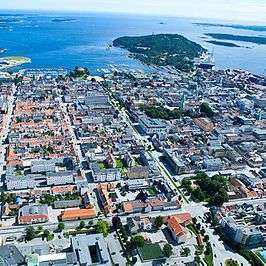  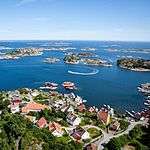 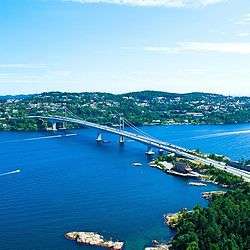 Descending, from top: Area photo of Kvadraturen, Street at Kvadraturen, Fiskebrygga, Bystranda, Flekkerøy, Varoddbrua E18 | |
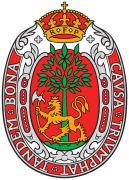 Coat of arms | |
| Nickname(s): Port of Norway | |
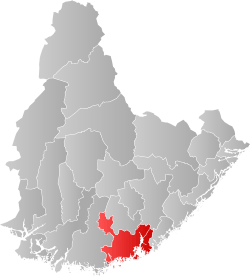 | |
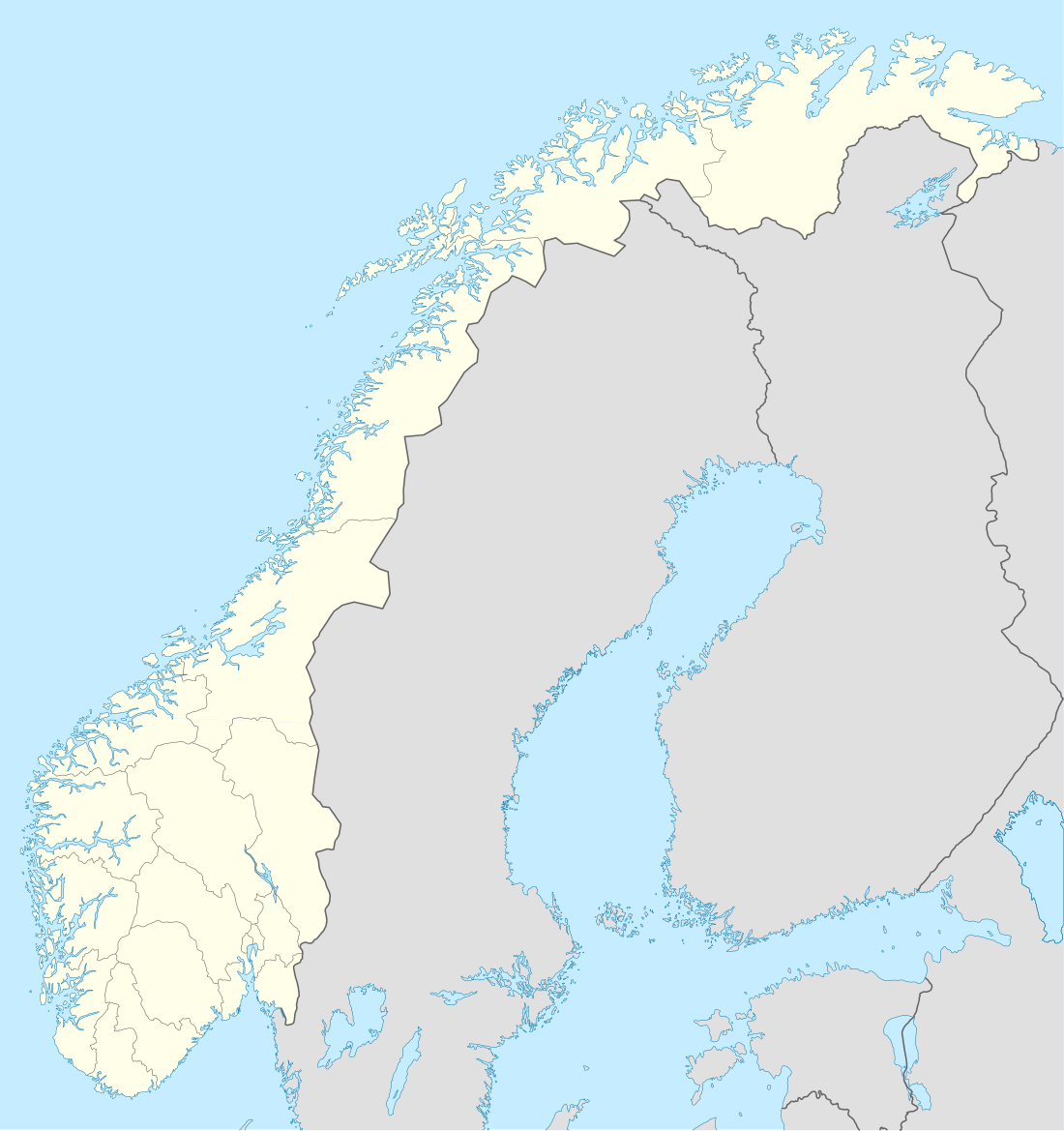 Kristiansand Location in Norway | |
| Coordinates: 58°8′50″N 7°59′50″E | |
| Country | |
| Municipality | Kristiansand |
| County | Agder |
| District | Kristiansandregion |
| Established | 1641 |
| Government | |
| • Mayor | Jan Oddvar Skisland (Ap) |
| Area | |
| • City & Municipality | 428.21 km2 (165.33 sq mi) |
| • Urban | 25.03 km2 (9.66 sq mi) |
| • Metro | 1,892.8 km2 (730.8 sq mi) |
| Population (30 September 2019) | |
| • City & Municipality | 93,205 |
| • Urban | 112,000 |
| • Urban density | 4,500/km2 (12,000/sq mi) |
| • Metro | 155,648 |
| • Metro density | 82/km2 (210/sq mi) |
| • Municipality/Urban rank | 6th/8th |
| • Metro rank | 5th |
| Demonym(s) | Kristiansander |
| Time zone | UTC+01:00 (CET) |
| • Summer (DST) | UTC+02:00 (CEST) |
| Website | www |
Kristiansand is connected by four main roads: European Route E18 from Oslo, Aust-Agder and covers the eastern part of Kristiansand; European route E39 from Stavanger, Flekkefjord and the coast towns and villages in Vest-Agder; Norwegian National Road 9 from Evje, Setesdal and Grim; and Norwegian National Road 41 from Telemark, northern Aust-Agder, Birkeland, Tveit and the airport Kristiansand Airport, Kjevik. Varodd Bridge is a large bridge and a part of E18, which stretches over Topdalsfjorden.
Tourism is important in Kristiansand, and the summer season is the most popular for tourists. Kristiansand Zoo and Amusement park is the largest zoo in Norway. It receives over 900,000 visitors every year. Markens Street is the main pedestrian street in downtown Kristiansand. Bystranda is a city beach located in Kvadraturen; in addition, Hamresanden beach is the longest beach in Kristiansand. Hamresanden Camping is a popular family camp during the summer season. The city hosts a free concert in downtown Kristiansand once every week in the summer. Outside the city is the industry park Sørlandsparken, which has Sørlandssenteret, the largest mall in Norway.
History
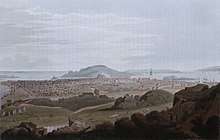
Prehistory and early history
The Kristiansand area has been inhabited since prehistoric times. In 1996, the well-preserved skeleton of a woman dating to approximately 6500 BC was discovered in the neighbouring municipality of Søgne. This demonstrates very early habitation of the archipelago. Grauthelleren (Grathelleren), located on Fidjane, is believed to be a Stone Age settlement. The first discovery in Norway of a Sarup enclosure (a Neolithic form of ritual enclosure first identified at Sarup on the Danish island of Funen) was made in 2010 at Hamresanden and dates to c. 3400 BC. Archaeological excavations to the east of Oddernes Church have uncovered rural settlements that existed during the centuries immediately before and after the start of the common era. Together with a corresponding discovery in Rogaland, these settlements are unique in the Norwegian context; isolated farms, rather than villages, were the norm in ancient Norway. Other discoveries in grave mounds around the church, in the Lund section of the city, indicate habitation beginning c. 400 AD, and 25 cooking pits that were found immediately outside the church wall in 1907 are probably even older. One of the largest pre-Christian burial grounds in South Norway was formerly located to the south and west of the church. A royal centre is thought to have existed at Oddernes before 800, and the church was built around 1040.
Before the stone church was built, one or perhaps two wooden post churches are believed to have stood on the same spot. A few years ago, excavations were carried out under and around the runestone when it was moved to the church porch; the grave finds indicated that the churchyard must already have been unusually large in the High Middle Ages. This means that the area must have had a large population before it was reduced by the Black Death.
In the 14th and 15th centuries, there was already a busy port and a small village on the Otra at the lowest point of today's Lund neighbourhood (Lahelle). Another important element in the development of Kristiansand was the harbor on the island of Flekkerøy, which was the most important on the Skagerrak beginning in the 16th century and was first fortified under King Christian III in 1555. In 1635, King Christian IV ordered his feudal seigneur, Palle Rosenkrantz, to move from Nedenes and build a royal palace on the island.
Foundation to 1900
Christian IV (renowned for having founded many towns) visited the location in 1630 and 1635, and on 5 July 1641 formally founded the town of Christianssand on the "sand" on the opposite bank of the Torridalselva (Otra). The town was laid out in Renaissance style on a grid plan (the central section now known as Kvadraturen = The Quarters), and merchants throughout Agder were commanded to move to the new town. In return, they were to receive a variety of trading privileges and a ten-year tax exemption.
In 1666, Christianssand became a garrison town and was heavily fortified. In 1682, King Christian V decided to relocate the bishopric there from Stavanger. Hence, the young city became the main city of the Christiansand Stift.
Christianssand experienced its first fire in 1734, which was devastating to the city. Later in the 18th century, after the American Revolutionary War, the town's shipbuilders experienced a boom that lasted until the Napoleonic Wars, when the continental blockade and naval warfare struck a severe blow to trade. Denmark–Norway supported France in the Wars and was therefore subjected to relentless attack by Britain, as recounted in Ibsen's Terje Vigen. Only in the 1830s did the economy begin to recover, and the growth in the Norwegian shipping industry was important for Christianssand.
The City of Kristiansand had a quarantine station for maritime traffic and hospital at Odderøy Island for cholera patients that opened in 1804. The city had far fewer deaths than the surrounding area, largely attributable to the quarantine station and the hospital. For example, during the period of 1833-1866, Drammen had 544 cholera patients, of which 336 died. During this same period, Kristiansand only experienced 15 deaths from cholera.[7]
.jpg)
Another important development during the 19th century was the foundation in 1881 of Eg Sindssygeasyl, the second central psychiatric institution in Norway (after Gaustad). The psychiatric hospital drew highly specialized doctors to the city and also provided many jobs for women.
The most recent major fire, in 1892, left half the original section of the city in ashes. It burned buildings as far as the cathedral, which had been rebuilt in brick after a previous fire in 1880.
1900 onward
With the development of hydropower in southern Norway, the city gradually developed an industrial base, particularly with the establishment in 1910 of the nickel refinery Kristiansands Nikkelraffineringsverk AS (later Falconbridge Nikkelverk, now Glencore Nikkelverk). From an economic perspective, the First World War was a good time for Kristiansand, as a neutral shipping city. The crises that followed with the gold standard politics of the 1920s and the world economic crisis of the 1930s were also deeply felt in a trading city like Kristiansand.
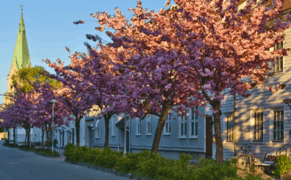
The labour movement had important pioneers in the city, and Leon Trotsky spent about a year of his exile in the archipelago offshore from Kristiansand. Arnulf Øverland took him from Randesund to Ny-Hellesund in Søgne in 1936.[8] In the interwar period Kristiansand was a centre for intellectuals, especially after the architect Thilo Schoder settled there in 1932.
Kristiansand was attacked by German naval forces and the Luftwaffe during the Operation Weserübung on 9 April 1940. The naval forces met fierce resistance from Norwegian coastal artillery at Odderøya. Bombs and grenades also hit the downtown and the 70 meter high church tower of the Kristiansand Cathedral was hit by accident. The third attack attempt on the city succeeded because a signal flag was confused with a French national flag and the misunderstanding was not discovered until it was too late. The city was occupied by a force of 800 men.
Post-war construction included further development of the Lund section, and in the 1960s and 1970s Vågsbygd to the west was developed into a section with 20,000 inhabitants. In the 1980s, industry and business in the city declined, in part because of the 1986 fire at the Hotel Caledonien. But beginning in the second half of the 1990s, business increased in momentum with the development of enterprises for marine and offshore equipment, security technology and drilling.
The older municipal archives for Kristiansand (and the former municipalities) are currently held at the Inter-Municipal Archives in Vest-Agder (IKAVA). This includes documents concerning, for example, local councils, chairmanships, poor boards, school boards and archives including among other things personal documents in the form of client records, tax records, and also school records.
On 1 January 2020, the three neighbouring municipalities of Kristiansand, Songdalen, and Søgne will be merged to form one large municipality called Kristiansand.[9]
Name
The city is named for King Christian IV, who founded it on 5 July 1641. The second element, sand, refers to the sandy headland the city was built on (see also Lillesand).
The name was often written Christianssand until 1877, although the map of the mapmaker Pontoppidan from 1785 spelled the name Christiansand (single 's'). That year, an official spelling reform with the purpose of making the city names "more Norwegian" changed it to Kristianssand. Kristiansund and Kristiania, now Oslo, had their spellings changed under the same reform. Despite that, a number of businesses and associations retain the "Ch" spelling. The name was again changed to its present form, Kristiansand (single "s"), in 1889.
In 2012, the city's mayor, Arvid Grundekjøn, proposed that the city be renamed Christianssand, arguing that "Kristiansand" is grammatically meaningless and that Christianssand stands for tradition.[10] This was not very well accepted by the locals and the mayor has not pushed this further.
Coat-of-arms
The arms of Kristiansand were granted on 8 December 1909 and are based on the oldest seal of the city, dating from 1643. In 1643 King Christian IV granted the young town the right to use a seal with the Norwegian lion and the royal crown. The crown indicates that the city was founded by the king. The other major element in the arms is a tree. As the species of tree is not specified, there are several known versions with differently shaped trees. A second seal, from 1658, shows a tree with leaves and what look like pine cones.[11] On the base of the crown are the letters R. F. P., standing for Regna Firma Pietas, "Piety strengthens the realm"; this was Christian IV's motto. Around the seal of the city is its motto, Cavsa Triumphat Tandem Bona, "A good cause prevails in the end".[12]
Geography
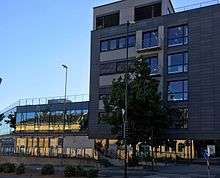
Kristiansand is strategically located on the Skagerrak, and until the opening of the Kiel Canal between the North Sea and the Baltic was very important militarily and geopolitically. This meant that for centuries it served as a military stronghold, first as Harald Fairhair's royal residence, then as a Danish-Norwegian fortress, and later as a garrison town. Kristiansand is a gateway to and from the continent, with ferry service to Denmark and a terminus of the railway line along the southern edge of South Norway.
Geologically, this part of Agder is part of the Swedo-Norwegian Base Mountain Shield, the southwestern section of the Baltic Shield, and consists of two main geological formations of Proterozoic rocks that were formed in the Gothic and later Swedo-Norwegian orogenies, with significant metamorphism during the latter.[13] There is a substrate of 1,600–1,450 million-year-old slate, quartzite, marble and amphibolite with some hornblende gneiss, and overlaid on this acidic surface structures of both granite and granodiorite (in general 1,250–1,000 million years old, in some places 1,550–1,480 million years old). The Bamblefelt geological area starts to the east of the municipality and extends to Grenland.
The last Swedo-Norwegian formations are evident in large formations of granite. There are also incidences of gabbro and diorite, less commonly eclogite. The Caledonian orogeny did not affect this area. Faults run southwest-northeast.[14] In ancient times there was a volcano off Flekkeroy, which left deposits of volcanic rock just north of central Kristiansand, on the site of the estate of Eg, now occupied by the Hospital of Southern Norway.
Near the city, there are deep woods. In Baneheia and at the former coastal artillery fortress on Odderøya, there are lighted ski trails and walking paths specially prepared for wheelchair users.
Two major rivers, the Otra and the Tovdalselva, flow into the Skagerrak at Kristiansand.
Climate
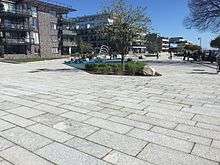
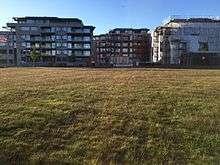
The climate in the city is warmer than most other places at the same latitude, but with cooler summers than farther east in Scandinavia. Its classified as oceanic climate (Köppen: Cfb) or humid continental climate (Dfb) by 0 °C isoterm due to marginality through Eurasia and North Atlantic Current.[15] The parts of the Agder counties on the Skagerrak coast, which includes Kristiansand, have a temperate climate with warm summers and cool winters. Snow generally occurs in late December and in January and February; it may be heavy (the snow record at Kjevik airport is 170 centimetres (67 in)) but rarely stays long on the coast; see Climate of Norway. The Gulf Stream provides local warming through surface currents along the Norwegian trench.
In the summer most locals go to the Fiskebrygga, the archipelago opposite the city, and Hamresanden Beach, which is located about 10 minutes from the city centre near Kjevik airport. People from Denmark, Sweden, Germany, the UK and other European countries also visit this beach in the summer during their travels.
The average annual temperature oscillates around 7 °C (45 °F). In the winter, the temperature seldom drops below −10 °C (14 °F), but it usually happens 2-3 times a year. Average temperature in the coldest month, January ranges from −5 °C (23 °F) as a low to 1 °C (34 °F) as average high. But temperatures have tended to be higher in recent years. And in the warmest month July, the average daily temperature ranges from 11 °C (52 °F) as a low to 20 °C (68 °F) as a high. The highest temperature ever recorded in Kristiansand was 34.2 °C (93.6 °F) at Kristiansand airport, Kjevik. The temperature seldom reaches 30 °C (86 °F), but most days in July reaches 22 °C (72 °F) or more. The annual rainfall in Kristiansand is 1,380 mm (54 in). The highest average temperature for Kristiansand in July was set in 2014 where there was an average temperature of 19.2 °C (67 °F).
| Climate data for Kristiansand (1960-1990) | |||||||||||||
|---|---|---|---|---|---|---|---|---|---|---|---|---|---|
| Month | Jan | Feb | Mar | Apr | May | Jun | Jul | Aug | Sep | Oct | Nov | Dec | Year |
| Record high °C (°F) | 13.9 (57.0) |
15.8 (60.4) |
21.9 (71.4) |
23.7 (74.7) |
27.7 (81.9) |
30.4 (86.7) |
32.0 (89.6) |
34.2 (93.6) |
28.0 (82.4) |
22.4 (72.3) |
15.5 (59.9) |
13.6 (56.5) |
34.2 (93.6) |
| Average high °C (°F) | 1.3 (34.3) |
1.9 (35.4) |
4.4 (39.9) |
8.9 (48.0) |
14.3 (57.7) |
18.6 (65.5) |
20.1 (68.2) |
19.3 (66.7) |
15.6 (60.1) |
11.4 (52.5) |
6.2 (43.2) |
3.0 (37.4) |
10.4 (50.7) |
| Daily mean °C (°F) | −1.8 (28.8) |
−1.6 (29.1) |
1.1 (34.0) |
4.8 (40.6) |
10.0 (50.0) |
14.0 (57.2) |
15.6 (60.1) |
14.9 (58.8) |
11.7 (53.1) |
8.0 (46.4) |
3.2 (37.8) |
−0.2 (31.6) |
6.6 (44.0) |
| Average low °C (°F) | −4.8 (23.4) |
−5.1 (22.8) |
−2.2 (28.0) |
0.7 (33.3) |
5.6 (42.1) |
9.4 (48.9) |
11.1 (52.0) |
10.4 (50.7) |
7.8 (46.0) |
4.7 (40.5) |
0.2 (32.4) |
−3.4 (25.9) |
2.9 (37.2) |
| Record low °C (°F) | −25.0 (−13.0) |
−27.3 (−17.1) |
−18.5 (−1.3) |
−14.3 (6.3) |
−5.0 (23.0) |
2.0 (35.6) |
3.0 (37.4) |
2.5 (36.5) |
−2.5 (27.5) |
−5.0 (23.0) |
−12.0 (10.4) |
−19.0 (−2.2) |
−27.3 (−17.1) |
| Average precipitation mm (inches) | 121 (4.8) |
80 (3.1) |
87 (3.4) |
59 (2.3) |
86 (3.4) |
75 (3.0) |
88 (3.5) |
118 (4.6) |
141 (5.6) |
164 (6.5) |
164 (6.5) |
116 (4.6) |
1,380 (54.3) |
| Average snowfall cm (inches) | 15 (5.9) |
20 (7.9) |
5 (2.0) |
0 (0) |
0 (0) |
0 (0) |
0 (0) |
0 (0) |
0 (0) |
0 (0) |
0.5 (0.2) |
15 (5.9) |
50.5 (19.9) |
| Average precipitation days (≥ 1.0 mm) | 13 | 10 | 8 | 8 | 9 | 9 | 9 | 11 | 10 | 15 | 14 | 13 | 129 |
| Average snowy days | 8 | 8 | 2 | 0 | 0 | 0 | 0 | 0 | 0 | 0 | 1 | 6 | 25 |
| Mean monthly sunshine hours | 55.8 | 89.0 | 134.9 | 186.9 | 245.8 | 279.9 | 256.7 | 212.9 | 153.0 | 95.6 | 50.0 | 32.6 | 1,793.1 |
| Source: , The Weather Network,[16][17] Sunshine & Daylight Hours in Kristiansand[18] | |||||||||||||
Popular beaches
- Bystranda is a beach located at the city centrum. It is east on Kvadraturen and at Tangen. Nearby the beach is the swimming complex Aquarama with outdoor and indoors pools. Aquarama is next door to the hotel "Scandic Hotel Bystranda", which is Southern Norway's largest hotel. Some of Kristiansand's most expensive apartments is located east for the beach and the high school Tangen is nearby. Some of Bystranda's facilities is beach volleyball, playgrounds, skatepark, stairs to the water at deeper ground and it is easy design for handicaps and children. In the middle of the water in the bay, there is a sculpture. Palmesus is a yearly beach festival held on Bystranda, it is Scandinavia's largest beach festival.
- Hamresanden is located between Hånes and the airport Kristiansand Airport, Kjevik. It is 3 km (2 mi) long which makes it longest beach in Kristiansand. There is three camping places and an apartment hotel at the beach. The name comes from the nearby the subpart Hamre.
- Sømstranda is a nudist beach in Kristiansand located at Søm.
Boroughs
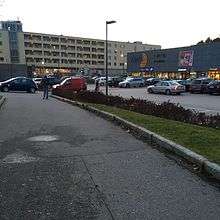
| Nr | Boroughs | Parts | Population [19] |
|---|---|---|---|
| 1 | Vågsbygd | Flekkerøy, Vågsbygd, Slettheia, Voiebyen | 36,281 |
| 2 | Grim | Grim, Hellemyr, Mosby, Strai, Tinnheia | 16,020 |
| 3 | Kvadraturen | Eg, Kvadraturen | 5,200 |
| 4 | Lund | Gimlekollen, Justvik, Lund, Ålefjær | 30,830 |
| 5 | Oddernes | Hånes, Randesund, Søm, Tveit | 19,080 |
| - | West | Vågsbygd, Grim, Kvadraturen | 57,501 |
| - | East | Lund, Randesund | 49,910 |
Parts
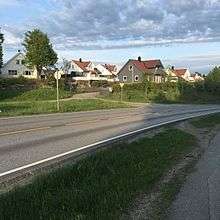
Kristiansand is partitioned into 18 parts and 217 subparts. Kristiansand is also divided into 5 boroughs.
Kvadraturen is the city center of Kristiansand. The area belonged to the farms Eg and Grim, and was a sandy plain covered with forest, and was called Sanden or Grimsmoen. Settlements were before the city was founded focused on loading and dumps at Lund, along Otra or Torridalselven and along Topdalsfjorden by Odderøya and Flekkeroy port. Christian IV's town plan outlined the city center with 56 rectangular squares with five long blocks and eight cross streets. It was the squares along the Otra and east and west harbor, which was built first. Today Kvadraturen is a part of Kvadraturen/Eg, which has (as of 1 January 2005) 5510 inhabitants. The area Posebyen in Kvadraturen is Northern Europe's longest continuous wooden buildings. In the parts are among others Kristiansand Cathedral, Kristiansand City Hall, Wergeland Park, and the terminal for ferries to Hirtshals and Kristiansand Station is located in the parts western corner.
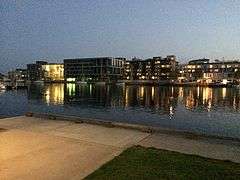
Kvadraturen (Kristiansand
residential and industrial areas. Vågsbygd has considerable industry, who has survived major changes. The largest employer is all the same Elkem Solar producing super clean Silicon for solar cells, which are located in premises that Elkem previous Ferrosilicon factory Fiskå Verk. On Andøya it established a significant and advanced mechanical industry which produces offshore and marine cranes and other marine equipment in Andøya Industrial Park. Amfi Vågsbygd is a major shopping center in Vågsbygd. Outside of Andøya in Vågsbygd is Bredalsholmen Shipyard and Preservation Centre, a Centre for protection of vessels at the former Bredalsholmen yard. Bredalsholmen Shipyard and Preservation Centre is a national hub for maintenance of museum ships and cherish worthy coastal culture, and a drydock with considerable capacity.
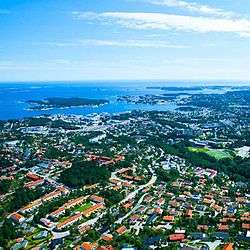
Vågsbygd]]]]
Lund is the second largest borough in Kristiansand with a population of 9,000 inhabitants in 2012. 14 June 1921 was the first 2.75 km2 of Lund transferred to Kristiansand and 1 January 1965 was also the rest of Lund part of Kristiansand in the municipal amalgamation. In Lund, there are traces of humans dating back to the early Iron Age, the Viking Age until the early Middle Ages various locations. There has been a settlement here since the Stone Age. During the Viking Age there was a great man's farm here. A Runestone at Oddernes church provides a connection to this farm. A large field with burial mounds formerly existed south and west of the church, and may also be associated with this farm. In 1492 robbers from the sea came and attacked Lund. This is mentioned in two letters located in the National Archives. The letters describe the attack that took place with a lot of violence against both women and men and that on both sides suffered casualties. No one know who the robbers were, but their centurion was named Per Syvertsen. The name suggests that he and his crew came from Norway or Denmark.
Indre and Ytre Randesund is located between Kvåsefjorden in Høvåg and the Topdalsfjord in Oddernes. Several small islands are situated alongside the cost of Randesund, among them Randøya and Herøya, both popular with summer tourists. The municipality (originally the parish) is named after the island, Randøen (now known as Randøya). The first part of the name is rand (Old Norse: rǫnd) which means "boundary" or "edge" and the last part of the name is sund which means "strait". The name was previously spelled Randøsund.
Tveit is a village and a former municipality in Vest-Agder county. It is located in the present-day municipality of Kristiansand. Tveit is home to Kristiansand Airport, Kjevik. Tveit is located along the lower part of the Tovdalselva river, known as Topdalselva from the border with Aust-Agder. The population of Tveit is approximately 2,900 (2014).
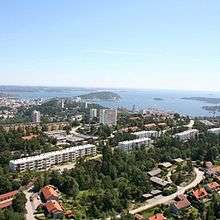
Tinnheia]] is a part in the Grim borough]]
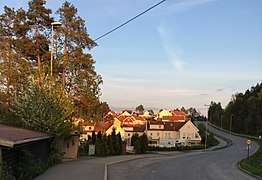
| Nr | Parts | Population |
|---|---|---|
| 1 | Flekkerøy | 3,270 |
| 2 | Voiebyen | 6,520 |
| 3 | Vågsbygd | 22,000 |
| 4 | Slettheia | 4,460 |
| 5 | Hellemyr | 2,990 |
| 6 | Tinnheia | 3,880 |
| 7 | Grim | 5,200 |
| 8 | Kvadraturen | 5,200 |
| 9 | Lund | 10,950 |
| 10 | Gimlekollen | 5,750 |
| 11 | Strai | 1,860 |
| 12 | Mosby | 2,090 |
| 13 | Justvik | 2,770 |
| 14 | Ålefjær | 410 |
| 15 | Tveit | 2,980 |
| 16 | Hånes | 4,210 |
| 17 | Søm | 9,410 |
| 18 | Randesund | 2,480 |
Subparts
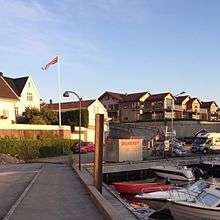
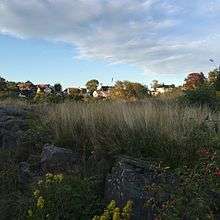
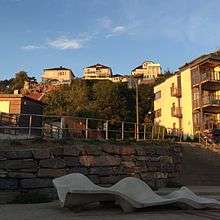
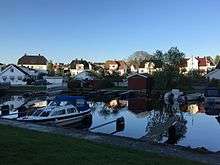
- Berge
- Lindebø
- Mebø
- Skålevik
- Åshavn
- Andøya
- Bråvann
- Kroodden
- Løvika
- Møvik
- Møviklia
- Rådyr
- Skutevika
- Spinneren
- Steindalen
- Ternevig
- Voie
- Voietun
- Voielia
- Voieåsen
- Augland
- Auglandsbukta
- Auglandskollen
- Auglandslia
- Bjørklia
- Furulia
- Granlia
- Kjerrheia
- Kjos Haveby
- Kjosneset
- Lumber
- Nordtjønnåsen
- Skyllingsheia
- Smiebrygga
- Storenes
- Vågsbygd sentrum
- Åsane
- Blørstad
- Fiskåtangen
- Gislemyr
- Gislemyrkollen
- Kartheia
- Karuss
- Rugde
- Slettheitoppen
- Trane
- Trekanten
- Øvre Slettheia
- Eigevannskollen
- Hannevika
- Hannevikåsen
- Kobolt
- Kolsberg
- Kolsåsen
- Tinnheia sørvest
- Tinnheia torv
- Tinnheia nord
Grim
- Artillerivollen
- Bellevue
- Dalane
- Enrum
- Fagervoll
- Grim torv
- Grimsmyra
- Elisenhøy
- Idda
- Klappane
- Krossen
- Møllevann
- Paradis
- Suldalen
Kvadraturen
- Baneheia
- Byskogen
- Eg
- Eik
- Gravane
- Gyldengården
- Markens
- Nybyen
- Odderøya
- Posebyen
- Strandrponomaden
- Tangen
Lund
- Agder Allé
- Bertesbukta
- Freyasdalen
- Gimle
- Gimlemoen
- Gimlevang
- Hamreheia
- Høivold
- Kjøita
- Kuholmen
- Kongsgård Allé
- Louvisenlund
- Lund torv
- Marvika
- Narviga
- Oddemarka
- Prestevik
- Skaugo
- Steinkleiva
- Sødal
- Tobienborg
- Vallhalla
- Vige
- Fagerholt
- Gimlekollen midtre
- Gimlekollen vest
- Gimlekollen øst
- Hestnestangen
- Prestheia
- Tretjønn
- Vollevannet
- Volleåsen
- Vige
- Øvre Kongsgård
- Aukland
- Gangdalslia
- Haslevollen
- Kulia
- Sagebekk
- Straismoen
- Torridal
- Ytre Strai
- Øvre Strai
- Hauslia
- Høie
- Høielia
- Høietun
- Kiledalen
- Lillefjell
- Ravnåsen
- Rismoen
- Saga
- Ytre Mosby
- Øvre Mosby
- Gjustvik
- Havlimyra
- Justlia
- Justnes
- Jærnesheia
- Kvernhusheia
- Skinnerheia
- Bjåvannet
- Einerhaven
- Kostøl
- Ålefjær
- Bliksheia
- Fuglevik
- Gudbrandslia
- Haumyrheia
- Kjellevik
- Knarrevik
- Korsvik
- Liane
- Nordlia
- Rona
- Saltbustad
- Strømme
- Sømslia
- Torsvik
- Torsvikkleiva
- Vardåsen
- Brattvollshei
- Boen
- Drangsholt
- Dønnestad
- Foss
- Hamre
- Hamresanden
- Kråkebumoen
- Moneheia
- Ryen
- Solsletta
- Ve
- Bjørndalen
- Brattbakken
- Grovikheia
- Heståsen
- Hånestangen
- Hånni
- Lauvåsen
- Nedre Hånes
- Nedre Timenes
- Ronsbukta
- Strømsdalen
- Timenes
Søgne
Søgne was a former municipality, located west of Kristiansand. The municipality was merged into a large municipality with the former municipality of Songdalen and the city of Kristiansand on January 1, 2020.
Songdalen
Songdalen was a former municipality, located northwest of Kristiansand. The municipality was merged into a large municipality with the former municipality of Søgne and the city of Kristiansand on January 1, 2020.
Notable streets
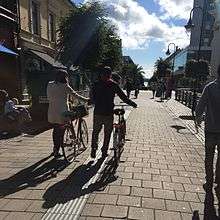
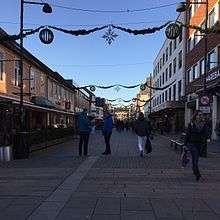
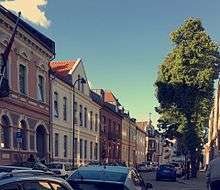
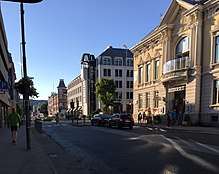
- Dronningens gate (Queens street) is a street that has its run from Havnegata Vestre harbor to Lund Bridge and is 980 meters long. 86 properties are matrikulert to the street. The street had in the 1700s the name Sand Alley.
- Elvegata (River street) has its run from Østre Strandgate to Tordenskjolds gate. It has a mix of newer business and residential buildings schools and nursing homes as well as a large percentage of older residential buildings in wood and masonry. On the south side of Østre Strandgate called extension of Elvegata for Tangen. 70 meters of the street, in the quarter between Dronningens gate and Tollbodgata is designated county road 26.
- Festningsgata is a street in Kvadraturen. The name is connected with Christiansholm Fortress from 1672 located in the street race extension towards the east harbor. The street stretches from Østre Strandgate to Tordenskjoldsgate and originally had the name Northern gate. The extension of the street during north of Tordenskjolds street is named Stener Heyerdahl street. The park south of Tordenskjolds street called Stener Heyerdahl park. This street stump and Festningsgata from Tordenskjolds street to Dronningens gate is part of the county road 28. From Vestre Strandgata to Tollbodgata buildings are listed by the walled green was introduced immediately after the fire in 1892 and forward.
- Henrik Wergelands gate is a street in Kvadraturen in Kristiansand. The street has its run from Vestre Strandgate to Elvegata. 118 properties are matrikulert to the street. It had previously named Consumer Julia Street. The street is named in honor of Norwegian poet Henrik Wergeland. In 1808 he had his early childhood in the town until he at nine moved with her family to Eidsvold.
- Tollbodgata (Tollbooth street) has its run from Senior wharf at Vestre port to Elvegata by Otra and is identical with Route 27 in Vest-Agder. 77 properties are matrikulert to the street. The street has previously had the name Sten Alley. Tolbooth.
- Vestre Strandgate (Western Beach Street) is a street that has its run from Gravane to roundabout at Gartnerløkka where it meets E18 and continue to run in Rv9 (Setesdalsveien). It is part of the county road 471 from the roundabout at Gartnerløkka the junction with Dronnings gata. From Rådhusgata to Gravane has two parallel paths, an extension of Fv471 and a container that separates the harbor from including Tolbooth. The street has a number of key meeting places and city functions in terms of Radisson Hotel,[20] Agder Theater, cinema, Clarion Hotel,[21] Kristiansand Bus Terminal and Kristiansand Station. The street is characterized by restaurants, pubs and eating places, a number of shops and offices and a few apartments.
Politics
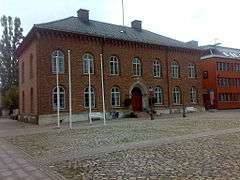
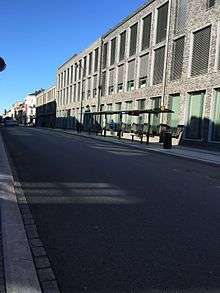
| Kristiansand city council 2015–2019 | Executive committee | |
| Labour Party | 15 (+1) | 3 |
| Conservative Party | 13 (-1) | 3 |
| Christian Democratic Party | 8 (-1) | 3 |
| Progress Party | 4 (-2) | 1 |
| Green Party | 3 (+2) | 1 |
| Liberal Party | 3 (0) | 1 |
| Democrats in Norway | 2 (0) | |
| Socialist Left Party | 2 (+1) | 1 |
| Pensioners' Party | 1 (-1) | |
| Red Party | 1 (0) | |
| Centre Party | 1 (+1) | |
| Total | 53 | 13[22][23] |
The city has no local parliamentary government, but is managed by the city council and an executive committee. The mayor is the spokesman for the city, head of the city council and leader of the executive committee. In Kristiansand the mayor has represented the center-right parties since the late 1940s.
2015 municipal council election
At the 2015 municipal election (the city council election) in Kristiansand had the parties that at the national level were in opposition progress. The greatest progress had the Green Party, which was a national trend. Labour Party became the largest party. The Conservative Party that the mayor represents had a little setback,[22] but the majority of the City Council once again chose a conservative mayor. New mayor was Harald Furre.[24]
Demographics
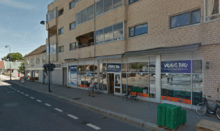
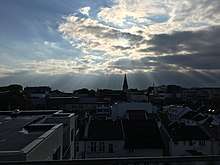
| Rank | Ancestry | Number |
|---|---|---|
| 1 | 1,940 | |
| 2 | 1,890 | |
| 3 | 1,390 | |
| 4 | 1,300 | |
| 5 | 1,280 | |
| 6 | 1,160 | |
| 7 | 1,070 | |
| 8 | 940 | |
| 9 | 880 | |
| 10 | 880 | |
| 11 | 840 | |
| 12 | 790 | |
| 13 | 700 | |
| 14 | 550 | |
| 15 | 540 | |
| 16 | 500 | |
| 17 | 420 | |
| 18 | 390 | |
| 19 | 390 | |
| 20 | 380 | |
| 21 | 360 | |
| 22 | 350 | |
| 23 | 320 | |
| 24 | 330 | |
| 25 | 320 | |
| 26 | 320 | |
| 27 | Other countries | 5,880 |
Kristiansand has the third largest Vietnamese community in Norway.
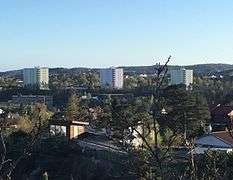
| Nr | District | Percent[19] |
|---|---|---|
| 1 | Slettheia | 36% |
| 2 | Kvadraturen | 24% |
| 3 | Grim | 22% |
| 4 | Hellemyr | 20% |
| 5 | Tinnheia | 19% |
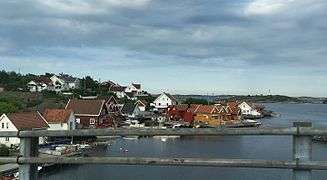
| Nr | District | Percent [19] |
|---|---|---|
| 1 | Flekkerøy | 7% |
| 2 | Randesund | 7% |
| 3 | Gimlekollen | 8% |
| 4 | Søm | 10% |
| 5 | Tveit | 10% |
Religion
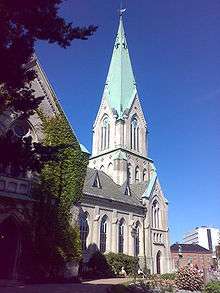
Christianity
Kristiansand Cathedral is the largest church in Kristiansand. It is located in Kvadraturen with the town hall and Wergelandsparken. The church was built in 1885 and have the capacity of 1500 people. The church is the seat of the Bishop of Agder and Telemark in the Church of Norway. Grim Church was built in 1969 and has a capacity of 750 people. Vågsbygd Church is the church of Vågsbygd, it is located in the centrum of Vågsbygd and was built in 1967 and has a capacity of 650. Lund Church was built in 1987 and has a capacity of 600 people. Søm Church was built in 2004 and has a capacity of 600. The church was Kristiansand municipality 1000 year building and is the largest church in Oddernes. The windows of Søm Church was designed by Kjell Nupen.
There are also churches located at Flekkerøy, Hellemyr, Hånes, Justvik, Oddemarka (Oddernes), Randesund, Strai (Torridal), Tveit and Voie. There are chapeaus all over the city. Christianity are strongest in Flekkerøy and Søm, even though Southern Norway is called the Norwegian Bible belt, Christianity doesn't play a big part in the rest of the city.
There is a Catholic church in Kvadraturen, St. Ansgar's Church. At Slettheia, there is a Latter-day Saint church and at Tinnheia, there is an Orthodox church.
The Church of Norway has twelve parishes (sokn) within the municipality of Kristiansand. It is part of the Kristiansand arch-deanery in the Diocese of Agder og Telemark.
| Parish (Sokn) | Church Name | Location of the Church | Year Built |
|---|---|---|---|
| Kristiansand domkirke | Kristiansand Cathedral | Kvadraturen | 1884 |
| Flekkerøy | Flekkerøy Church | Flekkerøya | 1960 |
| Grim | Grim Church | Grim | 1969 |
| Hellemyr | Hellemyr Church | Hellemyr | 1988 |
| Hånes | Hånes Church | Hånes | 1986 |
| Lund | Lund Church | Lund | 1987 |
| Oddernes | Justvik Church | Justvik | 1985 |
| Oddernes Church | Oddernes | c. 1040 | |
| Randesund | Randesund Church | Randesund | 1864 |
| Søm Church | Søm | 2004 | |
| Torridal | Torridal Church | Aukland | 1978 |
| Tveit | Tveit Church | Tveit | c. 1100 |
| Voie | Voie Church | Voie | 1990 |
| Vågsbygd | Vågsbygd Church | Vågsbygd | 1967 |
Buddhism
There is a Buddhist centre in Vågsbygd with Ternevig. There is also a Buddhist meditation centre located in the neighbouring municipality Songdalen.
Islam
There is a mosque in Kvadraturen.
Economy
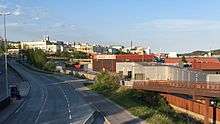
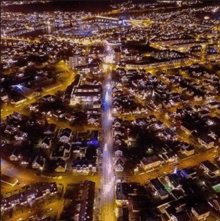
Christianssands Bryggeri is a producer of beer and soft drinks with a long history in the city. The brewery was established in 1859, and all products are made with spring water from the company's own spring, called Christian IVs kilde (Christian IV's spring).
Hennig-Olsen is an ice cream factory with headquarters and manufacturing facilities in Kristiansand. The factory opened in 1960, but the Hennig-Olsen family has produced ice cream in Kristiansand since 1924, when Sven Hennig-Olsen started doing so in the back of his tobacco kiosk.
Glencore Nikkelverk (nickel factory) was founded in 1910 as Kristiansand Nikkelraffineringsverk A/S. The company is owned by the Anglo-Swiss company Glencore and has about 500 employees.[27]
The Korsvik industrial area on the east side of the Kristiansandsfjord is home to companies working on drilling technology, cranes, winches and other equipment for the worldwide petroleum industry, among them National Oilwell Varco and Aker MH. Elkem, owned by China National Bluestar since 2011, operated a refining plant for ferrosilicon and microsilica at Fiskå in Vågsbygd for many years and was replaced in the beginning of the 20th century by Elkem Solar which produces polycrystalline silicon for wafers used in the solar cell industry. It has about 225 employees.[28]
Sørlandschips is a Norwegian produced crisps brand. The potatoes often come from Denmark. Sørlandschips owned by Scandza AS and is one of Norway's most popular potato chip brands today. It has a variety of tastes and spices.
Dampbageriet is a large bakery chain based in Vest-Agder, it was established in Kristiansand in 1862 and has 4 stores in Kristiansand.
Sparebanken Sør is a savings bank serving Vest-Agder, Aust-Agder and Telemark. It was established in 1824 when Christiansand Sparebank opened up, it was one of the first in Norway.
Hennig-Olsen Iskremfabrikk is a major Norwegian ice-cream company based and started up in Kristiansand. The factory is located in Hannevika.
As a relatively large shipping town, Kristiansand was a profitable location for shipbuilders Kristiansands Mekaniske Verksted and P. Høivolds Mekaniske Verksted. At one time, shipping companies were the backbone of the local economy, but not many survive. The Rasmussen Group, previously a shipping firm, is now an investment company.[29][30] Kristiansand continues to have major shipbuilding and repair facilities that support Norway's North Sea oil industry. The static inverter plant of the HVDC Cross-Skagerrak is located near Kristiansand.
Kristiansand Dyrepark is the zoo that sells most giraffe in Europe.

Sørlandsparken
Sørlandsparken (The Southern Norway Park) is an industrial shopping park outside of Kristiansand city in the municipality. The park is also 17 kilometers from Lillesand. The park has an area of 670,000 m2 (7,211,820 sq ft) and over 5,000 workplaces.
The main part of the industrial park is in Kristiansand, including the mall Sørlandssenteret with 195 stores and Kristiansand Zoo, it is the largest mall and zoo in Norway. The racetrack of Southern Norway is also located in Kristiansand while IKEA is located technically in Lillesand municipality.
Others large chainstores is also located around the mall.
There are two hotels located in Sørlandsparken and some resorts nearby the zoo.
E18 goes past Sørlandsparken before continuing to downtown Kristiansand. Buses are available 6-8 times in the hours all day.
Culture
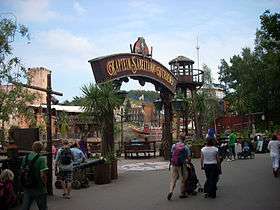
The Kristiansand Symphony Orchestra, Chamber Orchestra and Wind Ensemble merged in 2003. The orchestra now performs at the Kilden Performing Arts Centre, which opened in January 2012.[31] This is also the new home of Agder Theatre, founded in 1991.
Sørlandets Art Museum is in the centre of Kristiansand, in the former buildings of the cathedral school. It was established in 1995 building on the former collection of Christiansands billedgalleri, and is the second-largest regional art museum in Norway. It includes both fine art and crafts and runs an extensive programme of activities that includes exhibitions of the permanent collection, temporary exhibitions of contemporary art, and touring exhibitions to schools and child-care facilities.[32]
Christianssands Kunstforening, now renamed Kristiansand Kunsthall, is one of the oldest and largest art associations in Norway, founded in 1881, and has approximately 650 square metres (7,000 sq ft) of exhibition space for contemporary art in central Kristiansand. The association began assembling a permanent collection in 1902; this is now housed in Sørlandets Art Museum.
Cultiva, a local foundation, was established to ensure a portion of the profits made from selling shares in Agder Energy Ltd have lasting benefits to the community, focusing on art, culture, creativity and building competence; it supported projects in Kristiansand until the financial crisis forced cut-backs in 2011. In addition the Norwegian Directorate for Cultural Heritage endowed a cultural free port, Porto Rico, as one of the pilot projects of its "value creation project" in the 2000s.
In 2007 Kristiansand was awarded the designation Norges kulturkommune (Norway's culture municipality), a distinction awarded every other year by the Norwegian Culture Forum.
Fiskebrygga is a former fish landing on either side of the Gravane Canal, which separates the city centre from Odderøya; it was refurbished in the 1990s and now has wood-fronted buildings housing restaurants and shops including a fish market. It is very popular in summer, when the canal is also heavily used by boats.
The island of Odderøya is a former fortress and quarantine station, now used for recreation and excursion purposes. At times there are also concerts and festivals on the island.
The municipality millennium is Tresse - Retranchement, the city party space in front of Christiansholm Fortress, bottom Festningsgata the Baltic sea. The millennium was celebrated here include a large sign. A small sign to mark the Millennium for the future are made, but per. 2011 not installed in anticipation of the festival grounds shall be given a facelift. It should also dug a channel within the fortress, so this again is left on an island. These projects are waiting for political consideration and funding. Tusenårstreet were planted on the lawn between the festival grounds and playground/ice rink in Tresse.
Sports
The city's best known football team, IK Start, moved in 2007 to a new home stadium, Sør Arena. The city is also home to other football teams, including Fløy (Flekkerøy), Vigør and IK Våg. Kristiansand is also known for its handball teams (Kristiansands IF and IK Våg Vipers), ice hockey (Kristiansand Ishockeyklubb), basketball (Kristiansand Pirates) and volleyball (Grim VBK) clubs and has a baseball team (Kristiansand Suns).
Tourism
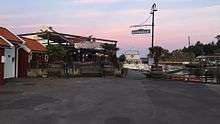
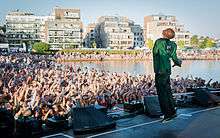
Kristiansand is a summer tourist destination, attracting many visitors in particular to its zoo, Kristiansand Zoo and Amusement Park, just east of the city. This is the second most visited attraction in Norway, after Holmenkollen, and had 925,000 visitors in 2012. Its animals, most of which are housed in natural habitats, include wolves, tigers, lions and the lynx. The zoo is open 365 days a year, while the amusement park is open during the summer season only.
The Quart festival was an annual music festival that took place in Kristiansand over five days in early July. There were large stages on Odderøya and smaller venues around the city. Founded in 1991 as Qvadradurmusivalen, the festival changed its name to the more catchy Quart Festival the following year. It included internationally known performers and was also known for booking acts that later became internationally known. For several years it was the largest music festival in Norway, but beginning in summer 2007 it was challenged by the Hovefestivalen on Tromøya, Arendal, and some Oslo-based festivals. In early June 2008 the organization declared bankruptcy; the festival returned in 2009 under the name Quart, but again went bankrupt.
Kristiansand is home to many other festivals as well, running throughout the year.[33] Protestfestival, held in September, was launched in 2000 and aims to address apathy and indifference in politics, and includes debates, concerts and lectures combined with performance art and documentaries. Protestfestival claims to attract anarchists, communists, hippies as well as conservative Christians and capitalists and to encourage communication among these radically different groups.[34] Others include Southern Discomfort, also in September, the Bragdøya Blues Festival in June, the Dark Season Festival in October, and Cultural Night and the International Children Film Festival in April.
Crime
Kristiansand has three police stations. The one in the city center, the main one for Southern Norway, Agder Police District. While on less serious crimes only covers some these parts of Kristiansand, Kvadraturen, Grim and Lund. Vågsbygd police station covers the Vågsbygd district while Randesund police station covers Randesund, Søm, Hånes and Tveit.
Most crim-cases reported in Kristiansand takes place on Kvadraturen. In south of Markens gate with Tollbodgata and Dronningens gate which host stores that are open 24 hours as well as many nightclubs. In 2014 it was most reported cases there in the entire city.
There were over 56 cases reported in this area and 123 on Kvadraturen in 2013, a decrease from 150 cases in 2012 reported on Kvadraturen. In the Vågsbygd police district it was reported that there were over 50 cases, going down 27% since 2012. At Randesund police station it was 61 cases reported, so had gone down 9% from 2012 to 2013. Outside of Kvadraturen, Vågsbygd and Randesund there were 110 cases reported in the municipality, mostly from Grim.
As of 2014, there were over 350 cases reported for all of Kristiansand. Of these, 34% were committed by minors on Kvadraturen. Most cases on Kvadraturen are narcotics, violence and nonprofit crimes; the majority being shop lifting. Six of the violent crime cases were against police and most violent acts were performed with knives. [35]
Minors
In crime performed by people under 18, there were most reported 16-year-old boys in 2013. Although adding the numbers of boys and girls together, the largest number of crime for the age was 14. It is simultaneously more that reports a mixed sex image where girls show an equal activity as boys. Some Instead there are also girls who are leading the way. Several executives tells increased used of bullying, intimidation and violence among girls. It looks including out that girls make greater use of social media such behavior. Some also report increased cannabis use among girls. The figures from the police show that nearly one in three young people who commit crimes have minority backgrounds. Of the 163 youths who embarked offense first half is 47 immigrants or Norwegian-born to immigrant parents. This represents 29% of the total number. The decline in the number of young offenders apply primarily the oldest group from 15 to 17 years. Kristiansand has several 14-year-olds than 17-year-olds who commit offenses. Girls make up more current through increased use of threats and violence.[36]
Contact from Voiebyen, Vågsbygd, Grim, Søm and Lund expressed concern about boys who challenge them with their behavior by breaking rules, commit vandalism, threaten classmates and try out various drugs. One of the schools have also been several incidents of violence against teachers and classmates. It is composed issues related to several of these students and they have various reasons major challenges in adapting to school requirements and expectations. Several executives from schools stated that they experience an increase in the number of pupils, both boys and girls, who are struggling mentally. They mention students with depression, social anxiety, eating disorder, self-mutilation and sleep problems. This worries them and they fear that some of these students, as a result of their poor mental health, are more vulnerable to make choices that can lead them into the environment with drugs and crime. To meet these challenges and provide these young people needed and customized follow-up, it is crucial to have a holistic focus and a good interdepartmental and interdisciplinary collaboration.[37]
Health
Sørlandet Sykehus HF is a hospital group in Southern Norway, they have three hospitals in Flekkefjord, Arendal and the main one on Eg in Kristiansand. It is only a 6 minutes drive from the city centrum Kvadraturen. The headquarter of Sørlandet Sykehus HF is also located in Kristiansand. The hospital has departments in Vågsbygd and Oddernes.
Eg hospital is an asylum/psychiatric hospital next to Sørlandet hospital. It was opened in 1881 by dr. Axel H. Lindboe, this became Norway's third insane asylum.
St. Josef hospital was a catholic hospital located at Kvadraturen, it was opened in 1885 and driven by his sisters. The hospital closed down in 1967.
There are 11 retirement homes in Kristiansand and most of them are located on Kvadraturen. One rehabilitation center, ca 15 fitness centers, 20 dentist offices, 10 medical centers and around 25 pharmacies.
Transportation
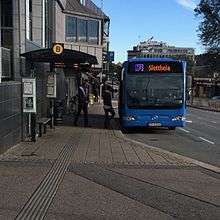
Kristiansand is an important transport and communications node, connected to continental Europe by air and sea.
Sea
From the city centre, the ferry harbour has routes to Hirtshals (Denmark) operated by both Color Line and Fjord Line.[38] Color Line operates their MS Superspeed 1, which entered into service in 2008 and spends approximately 3 hours and 15 minutes on the crossing. The route operates year-round with two crossings each way in one day. Fjord Line operates HSC Fjord Cat, which is a high-speed catamaran covering the route in around 2 hours and 15 minutes. The ship was built between 1997 and 1998, and has sailed under several different operators on many different routes. It only operates during the high season in the summer.
A new catamaran built by Australian ship-building company Austal will enter service at the start of summer 2020 and replace Fjord Cat. The new ship should double the capacity, while retaining the same travel duration of 2 hours and 15 minutes. Fjord Line also aims for the new ship to address complaints with seaworthiness and stability from its predecessor.
Road
European Road 18 is the largest highway in Kristiansand. It starts after E39 goes to Denmark before the city bridge on Kvadraturen. E18 continues out Kristiansand municipality and through Arendal, Oslo and ends in Stockholm. European Road 39 starts in Trondheim and has it course through Western Norway before following the coastal municipalities in Vest-Agder. When E39 comes to Kristiansand, it goes to the harbor and continues through Denmark. Norwegian National Road 9 is a road starting in Kristiansand, through Grim and then through Vennesla municipality before leaving Vest-Agder. The national road ends in Telemark at Haukeli, and is the most important road connection for Setesdalen and the surrounding regions.
Norwegian National Road 41 Norwegian National Road 41 starts in Hånes. It is the road out to Kristiansand Airport, Kjevik, it continues to Birkenes and ends in Kviteseid, Telemark. County road 401 is the old E18 before it got upgraded. It starts on Søm and ends in Lillesand, it goes via Høvåg. County road 452 is the old road to Vennesla city centrum. It starts on Lund, then goes through Justvik and Ålefjær before Vennesla municipality. County road 456 is the main road in Vågsbygd and afterwards ending in Søgne. County road 457 takes up from 456 in Voiebyen and ends at Flekkerøy. County road 471 is the largest road in downtown Kristiansand. It ends at Lund and goes besides the University.
Bus
Buses in the city and surrounding region are operated by Boreal Buss AS, who won the tender from Agder Kollektivtrafikk in 2018 to operate routes for seven years, with an option to extend the period by three years. Previously, Nettbuss Sør (South) operated buses in the region for eight years from 2010 to 2018. All regional bus lines goes through three stops in Kvadraturen. Some bus lines goes vice versa from the west coast to the east coast of the city.
Kristiansand Bus Terminal or Kristiansand Rutebilstasjon is the main bus terminal for the city, and also acts as a hub for express-buses connecting to Oslo, Stavanger and Haukeli. It is located by the train station Kristiansand S. The bus terminal has local, regional and long-distance bus routes. A new bus terminal was constructed in 2019, replacing the old and outdated building from 1960. The old terminal will be demolished and replaced by a small park and green-space.
The local city buses in Kristiansand has their main stop in Kvadraturen with city terminals in the streets Henrik Wergelands gate (eastbond or end for westbound) and Tollbodgata (westbound or end for eastbound), both streets crosses Markens gate. City bus lines 01, A1 starts in Kvadraturen and goes by UiA and Rona. M1, M2, M3, 12, goes by Vågsbygd centrum. 17, 18 joins M1, M2, M3 and 12 for Hannevika. 40, 42, 50 and 45, 46 goes only Hannevika. Line 40, 42, 45, 46 and 50 stops in Kristiansand Bus Terminal expect in the rush hours, while M1, M2, M3, 12, 17 and 18 continues to Henrik Wergelands gate, UiA, Rona, then their destinations. Line 13, 15, 19, 32 and 30 comes north for Kvadraturen and goes by Grim torv. Line 22, 23 only goes by UiA. Line 31 goes Line 35, 36 and 37 goes by Ve, Rona, UiA, Tollbodgata and ends in Kristiansand Bus Terminal. There are also local buses in some of the boroughs like Vågsbygd: Line 51, 52 and 55 goes from neighbourhoods in the borough to Vågsbygd centrum collaborating with M1 or M2 at selective times. Line 57 goes from east to west on the main road in Flekkerøy. Line 58 goes locally in Randesund to Rona.
Railway
Kristiansand Station opened in 1895 and is located in the city centre, close to the ferry terminal. It is owned by Norwegian National Rail Administration. The Sørlandet Line goes through small towns in Vest-Agder and Aust-Agder counties. Express trains go east to Oslo S. Regional lines goes to Stavanger.[39]
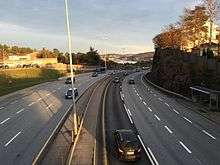
Aviation
The local airport, Kjevik, is located 12 km (7.5 mi) east of the city centre and has routes to European and Norwegian cities. A new one-storey parking garage was constructed in 2019.
Travel distances
Distance from Kristiansand to other cities:[40]
- Mandal 36 kilometers (23 miles) (considerably shortened when new E39 opens in 2022)
- Evje 49 kilometers (30 miles)
- Arendal 55 kilometers (34 miles)
- Flekkefjord 81 kilometers (50 miles)
- Stavanger 160 kilometers (100 miles)
- Oslo 250 kilometers (155 miles)
- Bergen 292 kilometers (181 miles)
- Trondheim 601 kilometers (373 miles)
- Tromsø 1382 kilometers (859 miles)
- Copenhagen 391 kilometers (243 miles)
- Stockholm 768 kilometers (477 miles)
Education
The University of Agder was established in 2007, based on Agder College, which had been founded in 1994 by the amalgamation of six previous institutions: Kristiansand Teacher Training College, Agder District College, Kristiansand College of Nursing, Arendal College of Nursing, Agder Engineering and District College (Grimstad) and Agder Conservatory of Music. The university has about 10,000 students, of whom 7,500 are in Kristiansand and the remaining 2,500 in Grimstad. In Kristiansand it is housed on a campus on the former parade ground of Gimlemoen in the Lund section. The university offers a wide range of studies at all levels, organised into five faculties: Humanities and Education, Engineering and Science, Health and Sport, Economics and Social Sciences, and Fine Arts. Gimlemoen is also the site of Sørlandet kunnskapspark, a research park built with funds from sources including the Cultiva foundation that houses a number of companies with a degree of professional affiliation with the university, such as Agderforskning, a social science research institute that is part of the publishing company Cappelen Damm.[41]
Noroff University College was established in 2012 and is a private university offering specialised degrees two in Interactive media (Games or Animation) and Applied Data Science and in Digital Forensics. The University College builds on Noroff's existing vocational school which originally opened in 1987. In addition to the Kristiansand Campus Noroff has facilities in Oslo, Bergen and Stavanger. Noroff has considerable experience in offering online courses and all of the degree courses offered at the University College are available online.
Kristiansand was a garrison and cathedral town from 1664; Kristiansand Cathedral School was founded in 1684 and a Latin school in 1734. There are currently four public senior secondary schools: Kristiansand Cathedral School Gimle,[42] Vågsbygd High School, Kvadraturen skolesenter and Tangen High School
Private senior secondary schools include Sonans utdanning (education). The private school Sørlandets Maritime Senior Secondary School is also based in Kristiansand. This school offers two courses of study, Technology and Industrial Production and maritime subjects. It is a boarding school; students live and undergo training aboard the training ship MS Sjøkurs, a steamer that previously operated on the Hurtigruten.
Kristiansand is also host to an International School on Kongsgård Alle in Lund. The School opened in January 2008 to provide an international education through English to students from grade 1 to grade 10. This IB authorised school moved into a brand new purpose built building in Summer 2014, to house the expanding school which now has over 100 students.
List of schools in Kristiansand[43][44]
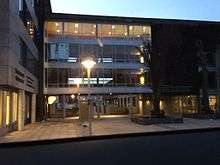
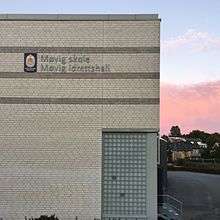
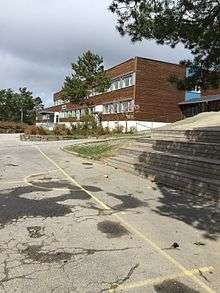
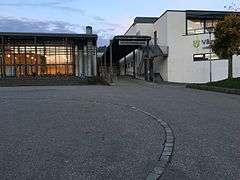
| Name | Type | District | Students | Status |
|---|---|---|---|---|
| Dvergsnes skole | Elementary | Oddernes | 360 | Public |
| Fagerholt skole | Elementary | Lund | N/A | Public |
| Fiskå skole | Junior High | Vågsbygd | 300 | Public |
| Flekkerøy skole | Elementary | Vågsbygd | N/A | Public |
| Grim skole | Junior High | Grim | 500 | Public |
| Haumyrheia skole | Junior High | Oddernes | 300 | Public |
| Havlimyra skole | Junior High | Lund | N/A | Public |
| Hellemyr skole | Elementary | Grim | N/A | Public |
| Holte skole | Junior High | Oddernes | 250 | Public |
| Hånes skole | Elementary | Oddernes | N/A | Public |
| Justvik skole | Elementary | Lund | N/A | Public |
| Karl Johan minneskole (memorial) | Elementary | Grim | 250 | Public |
| Karuss skole | Elementary and Junior High | Vågsbygd | N/A | Public |
| Kongsgård skolesenter | Elementary | Lund | 900 | Private |
| Kringsjå skole | Elementary | Randesund | N/A | Public |
| Krossen skole | Elementary | Grim | N/A | Public |
| Kristiansand Cathedral School | High School | Lund | 1,360 | Public |
| Kristiansand International School | Elementary and Junior High | Lund | N/A | Private |
| Kvadraturen skolesenter | High School | Kvadraturen | 1,500 | Public |
| Lindebøskauen skole | Junior High | Vågsbygd | N/A | Public |
| Lovisenlund skole | Elementary | Lund | N/A | Public |
| Mosby skole | Elementary | Mosby | N/A | Public |
| Møvig skole | Junior High | Vågsbygd | 400 | Public |
| NLA Mediehøgskolen Gimlekollen | College | Lund | 130 | Private |
| Oddemarka skole | Junior High | Lund | N/A | Public |
| Prestheia skole | Elementary | Lund | N/A | Public |
| Sjøstrand skole | Elementary | Vågsbygd | N/A | Public |
| Slettheia skole | Elementary | Vågsbygd | N/A | Public |
| Solholmen skole | Elementary | Grim | 200 | Public |
| Steinerskolen | Elementarty and Junior High | Lund | N/A | Private |
| Strømme skole | Elementary | Oddernes | 370 | Public |
| Sørlandets maritime videregående skole | High School | MS "Sjøkurs" | 60 | Private |
| Tangen vidergående | High School | Kvadraturen | 1,000 | Public |
| Tordenskjoldsgate skole | Elementary | Kvadraturen | 150 | Public |
| Torkelsmyra skole | Elementary | Vågsbygd | N/A | Public |
| Torridal skole | Elementary and Junior High | Grim | N/A | Public |
| Universitetet i Agder | University | Lund | 11,500 | Public |
| Vardåsen skole | Elementary | Oddernes | 350 | Public |
| Ve skole | Elementary and Junior High | Oddernes | N/A | Public |
| Vigvoll skole | Junior High | Oddernes | 200 | Public |
| Voiebyen skole | Elementary | Vågsbygd | N/A | Public |
| Vågsbygd skole | Elementary | Vågsbygd | 270 | Public |
| Vågsbygd vidergående | High School | Vågsbygd | 800 | Public |
| Frank Wild Minneskole (memorial) | Elementary | Lund | N/A | Public |
| Øvre Slettheia skole | Elementary | Vågsbygd | N/A | Public |
| Åsane skole | Elementary | Vågsbygd | N/A | Public |
Media
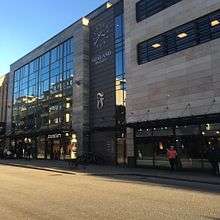
Fædrelandsvennen is the main news paper in Kristiansand and the Kristiansand Region. The paper has around 116 000 readers every day and was founded in 1875. From 2006, the newspaper went from broadsheet to tabloid. Fædrelandsvennen was located at Rådhusgata with Wergelandsparken (A park named after Henrik Wergeland) until 02.27.192 when someone blew up the building and it burned down to the ground. Nobody lost their lives in the incident. The newspaper relocated to Fiskåtangen in Vågsbygd where it located until 2015 when it moved back downtown to Henrik Wergelands gate. Fædrelandsvennen have ownership in many Southern Norway based newspapers, TV-Channels radio stations and other companies.
Kristiansand Avis (Kristiansand Newspaper) is a free newspaper paid by ads, and is delivered to all households in the region except Lillesand, Birkenes and Iveland. The newspaper is focused on staying closed to the local people. It comes out each Thursday and had 45 000 readers in 2014.
NRK Sørlandet has their main office in Kristiansand. It is the district office for the national broadcasting channel NRK. NRK Sørlandet covers Aust-Agder and Vest-Agder County. They produce 6 hours of radio and one and a half hour of television, in addition to their own website for news for Southern Norway.[45]
Notable people
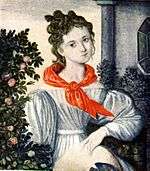
- Agnes Kittelsen (b. 1980), an actress.
- Andreas Thorkildsen (b. 1982), a javelin thrower from Vågsbygd. He was olympian champion in 2004 and 2008, and World champion in 2009. He sat the world junior record in 2001.
- Anton Jörgen Andersen, composer.
- Bernt Balchen (1899–1973), an aviation pioneer, aircraft mechanical, engineer and US military leader.
- Camilla Collett (1813–1895), a writer and Norway's first feminist.
- Anton Carl Hartmann (1803-??), member of parliament
- Else Marie Jakobsen (1927–2012), a textile artist and designer.
- Finn Benestad, musicologist and music pedagogue
- Frida Aasen, (b. 1994) a model.
- Henrik Wergeland (1808–1845), a poet, playwright and writer are only a few things.
- Hilde Hefte (b. 1956), a jazz singer.
- Jens Bjørneboe (1920–1976), a novelist.
- Joseph Frantz Oscar Wergeland (1815–1895), a military officer.
- Katrine Lunde, a handball player from Hånes, she plays for the national handball team in Norway.
- Kjell Nupen (1955–2014), a contemporary artist who has designed a lot of work around the world.
- Kristine Lunde-Borgersen, (b. 1980), a handball player who become an Olympian champion three times.
- Kristoffer Hæstad (b. 1983), a former football player from Vågsbygd, he played for IK Start, then Vålerenga Fotball.
- Kristoffer Halvorsen, cyclist.
- Mette-Marit, Crown Princess of Norway (b. 1972), the crown princess of Norway from Slettheia, married Crown Prince Haakon in 2001.
- Nicolai Tangen (b. 1966), hedge fund manager and philanthropist.
- Per Fronth (b. 1963), a visual artist, photographer and painter.
- Rolf Løvland (b. 1955), a songwriter and composer.
- Terje Formoe, (b. 1949) a singer, songwriter and actor.
- Tor Fuglevik, media manager
- William Brede Kristensen, church historian
- Helene Abildsnes (b. 1998), beauty pageant titleholder who won Miss Universe Norway 2019
Twin towns – Sister cities
Kristiansand is twinned with:
See also
Notes
- Even though the names are different, Kristiansand is often noted as Kristiansand S (S for South) to distinguish it from Kristiansund, also in Norway, in such cases noted as Kristiansund N. The practice originated before postal codes were introduced, as mail sometimes was sent to the wrong city. Occasional mix-ups with the Swedish city of Kristianstad have also been known to happen.[1]
References
- "EUROPE | Soldiers' map mix-up". BBC News. 26 May 2000. Retrieved 14 May 2013.
- "Kristiansand". Collins English Dictionary. HarperCollins. Retrieved 24 April 2019.
- "Kristiansand". Oxford Dictionaries UK Dictionary. Oxford University Press. Retrieved 24 April 2019.
- "Kristiansand". Merriam-Webster Dictionary. Retrieved 24 April 2019.
- "Folkemengd og kvartalsvise befolkningsendringar, 3. kvartal 2013" (in Norwegian). 21 November 2013.
- "Justvik - landsby i kommunen Kristiansand. Befolkningen - hvor mange mennesker Justvik". Befolkningen.com. Retrieved 14 May 2013.
- Torstveit, L.; Vesterhus, P. (15 December 2005). "Kolera og karantene i Kristiansand" [Cholera and quarantine in Kristiansand]. Tidsskr Nor Laegeforen (in Norwegian and English). 125 (24): 3490–3. PMID 16357901. Retrieved 2 May 2017.
- Langfeldt, Jan G. (2004). Langfeldt-slektens og Ny-Hellesunds historie (in Norwegian). p. 80. ISBN 82-994591-2-5.
- "Nye Kristiansand" (in Norwegian). Kristiansand kommune. Archived from the original on 1 September 2019. Retrieved 5 November 2017.
- "Kristiansand eller Christianssand? - Sørlandet - NRK Nyheter". Nrk.no. Retrieved 14 May 2013.
- Norske Kommunevåpen (1990). "Nye kommunevåbener i Norden" (in Norwegian). Retrieved 27 September 2008.
- "Regler om bruk av Kristiansands byvåpen og segl i ikke kommunalt øyemed" (PDF) (in Norwegian). Municipality of Kristiansand. 23 August 1989. Archived from the original (PDF) on 25 December 2013. Retrieved 24 December 2013.
- Ivar B. Ramberg et al., Landet blir til – Norges geologi, Norsk geologisk forening 2006 (2007), p. 71
- Berggrunnskart over Norge, Norwegian Geological Survey, 2006 (in Norwegian)
- "Kristiansand climate: Average Temperature, weather by month, Kristiansand weather averages - Climate-Data.org". en.climate-data.org. Retrieved 4 March 2019.
- "Climate Statistics for Kristiansand-Duekniben, Norway (2013-2014)". 26 November 2014.
- "Yr - Været som var". yr.no. Retrieved 17 September 2016.}
- "Yr - Sunshine & Daylight Hours in Kristiansand, Norway". yr.no. Retrieved 17 September 2016.
- "Befolkning i Kristiansand". ssb.no. Retrieved 17 September 2016.
- Radisson Blu Hotel Caledonien (in English)
- Clarion Hotel Ernst (in English)
- Resultater valg 2015 NRK (in Norwegian)
- List of members of the executive committee, Kristansand Folkevalgtbasen (in Norwegian)
- Harald Furre valgt til ordfører Archived 26 December 2015 at the Wayback Machine www.kristiansand.kommune.no (in Norwegian)
- "Ungdom og kriminalitet" (PDF). kristiansand.kommune.no. Archived from the original (PDF) on 16 July 2014. Retrieved 10 April 2015.
- "Den Norske Kirke". kirken.no. Retrieved 8 October 2015.
- Velkommen til Glencore Nikkelverk AS Archived 8 September 2015 at the Wayback Machine XtrataNickel.no. Retrieved 20 November 2013
- Peder Qvale (12 September 2012)Lite solskinn for Elkem Solar Teknisk Ukeblad. Retrieved 29 December 2013 (in Norwegian)
- Harald Berglihn, "Rasmussengruppen reddet av aksjer og finans", Dagens Næringsliv, 31 May 2011, retrieved 20 November 2013 (in Norwegian)
- Rasmussengruppen AS Rasmussengruppen.no. Retrieved 29 December 2013 (in Norwegian)
- Kilden Performing Arts Centre Archived 30 January 2012 at the Wayback Machine
- Sørlandets Kunstmuseum, Homepage in English
- What's on in Kristiansand www.visitnorway.com (in English)
- Protestfestivalen (English) Archived 17 March 2012 at the Wayback Machine
- "Kriminalitet i Kristiansand kommune" (PDF). kristiansand.kommune.no. Archived from the original (PDF) on 16 July 2014. Retrieved 10 April 2015.
- "Ungdom og kriminalitet i Kristiansand" (PDF). Agderforskning.no. Archived from the original (PDF) on 4 March 2016. Retrieved 25 March 2015.
- "Ungdom og kriminalitet i Kristiansand". pkforum.no. Archived from the original on 2 April 2015. Retrieved 25 March 2015.
- Kristiansand Port
- NSB Homepage
- "Distance Calculator Find Distance Between Cities". www.distancecalculator.net. Retrieved 7 November 2015.
- University of Agder, official website(in English)
- Kristiansand Cathedral School, history (official website) (in Norwegian)
- "Min skole (My school)". minskole.no. Retrieved 10 April 2015.
- "Skoleportal / Vest-Agder fylkeskommune". vaf.no. Archived from the original on 14 March 2016. Retrieved 10 April 2015.
- "NRK Sørlandet". NRK Sørlandet (in Norwegian Bokmål). Retrieved 14 February 2016.
- "International co-operation of Gdynia". Gdynia.pl. Archived from the original on 19 October 2016.
- "Münster partnerstaedte". muenster.de. Archived from the original on 9 May 2013. Retrieved 9 May 2013.
External links
| Wikivoyage has a travel guide for Kristiansand. |
| Wikimedia Commons has media related to Kristiansand. |
| Wikisource has the text of the 1911 Encyclopædia Britannica article Christiansand. |
| Look up Kristiansand in Wiktionary, the free dictionary. |
- Municipal fact sheet from Statistics Norway (in Norwegian)
- What's on in Kristiansand
- Kristiansand Virtual Tour, 360* Panoramic Pictures (QTVR)
- Chisholm, Hugh, ed. (1911). . Encyclopædia Britannica. 6 (11th ed.). Cambridge University Press. p. 291.
